Understanding IP Multicast PIM Modes
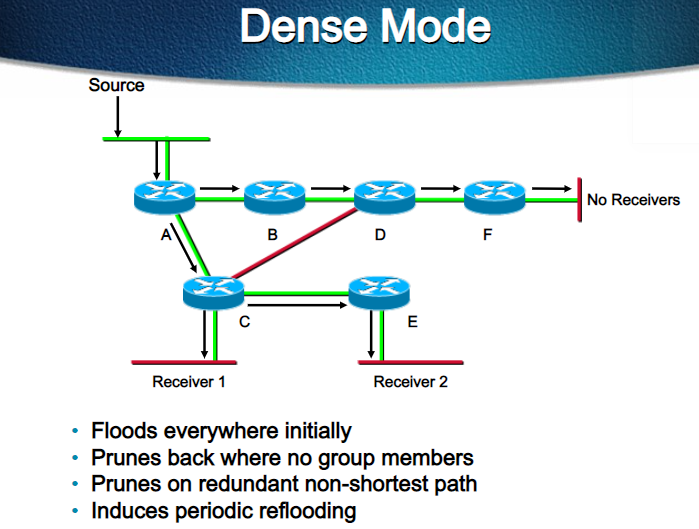
What is PIM (Protocol Independent Multicast)
PIM is IP routing protocol-independent and can leverage whichever unicast routing protocols are used to populate the unicast routing table, including Enhanced Interior Gateway Routing Protocol (EIGRP), Open Shortest Path First (OSPF), Border Gateway Protocol (BGP), and static routes. PIM uses this unicast routing information to perform the multicast forwarding function. Although PIM is called a multicast routing protocol, it actually uses the unicast routing table to perform the RPF check function instead of building up a completely independent multicast routing table. Unlike other routing protocols, PIM does not send and receive routing updates between routers.
PIM Modes
1- PIM Dense Mode (PIM-DM):
PIM-DM uses a push model to flood multicast traffic to every corner of the network. This push model is a brute force method for delivering data to the receivers. This method would be efficient in certain deployments in which there are active receivers on every subnet in the network.
PIM-DM initially floods multicast traffic throughout the network. Routers that have no downstream neighbors prune back the unwanted traffic. This process repeats every 3 minutes.

Routers accumulate state information by receiving data streams through the flood and prune mechanism. These data streams contain the source and group information so that downstream routers can build up their multicast forwarding table. PIM-DM supports only source trees, that is, (S, G) entries, and cannot be used to build a shared distribution tree.
2- PIM Sparse Mode (PIM-SM):
PIM-SM uses a pull model to deliver multicast traffic. Only network segments with active receivers that have explicitly requested the data will receive the traffic.
PIM-SM distributes information about active sources by forwarding data packets on the shared tree. Because PIM-SM uses shared trees (at least, initially), it requires the use of a rendezvous point (RP). The RP must be administratively configured in the network.

Sources register with the RP and then data is forwarded down the shared tree to the receivers. The edge routers learn about a particular source when they receive data packets on the shared tree from that source through the RP. The edge router then sends PIM (S, G) join messages towards that source. Each router along the reverse path compares the unicast routing metric of the RP address to the metric of the source address. If the metric for the source address is better, it will forward a PIM (S, G) join message towards the source. If the metric for the RP is the same or better, then the PIM (S, G) join message will be sent in the same direction as the RP. In this case, the shared tree and the source tree would be considered congruent.
Unidirectional Shared Tree and Source Tree in PIM-SM:
The figure below shows a standard PIM-SM unidirectional shared tree. The router closest to the source registers with the RP (part A in the figure)and then creates a source tree (S, G) between the source and the RP (part B in the figure). Data is forwarded down the shared tree (*, G) towards the receiver from the RP.
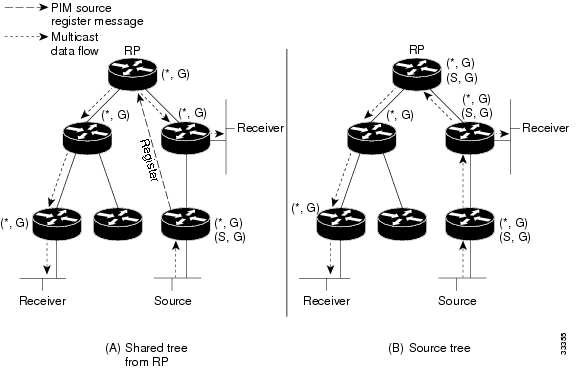
In other words, In PIM-SM, two Distribution Tree are created (S,G) & (*,G):
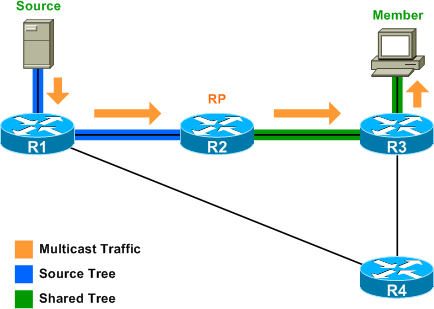
1- A source Tree (from the source to RP): The Source sends “PIM register message” to join the Group.
The interface to the source is added to the incoming interface in the source mroute.
Maintaining a source tree from the source to the RP ensures the RP knows the address of the multicast source(s) for the group.
2- Shared Tree (from RP to the receivers): When a receiver (Member) sends an IGMP request to join the Multicast group, The edge router (R3) annotates the IGMP join in its multicast routing table and sends a PIM join request for the group to the RP (R2).
The RP receives the join request from R3, and adds FastEthernet0/1 (to R3) in the outgoing interface lists for both mroutes (source and shared).
Note: Only the RP knows about the source Tree (S,G), R3 has only a shared tree mroute (*,G) (from RP).
For more about PIM-SM Distribution Trees:
https://packetlife.net/blog/2008/oct/20/pim-sm-source-versus-shared-trees/
3-Bidirectional PIM (Bidir-PIM)
Bidirectional PIM (bidir-PIM) is an enhancement of the PIM protocol that was designed for efficient many-to-many communications within an individual PIM domain. Multicast groups in bidirectional mode can scale to an arbitrary number of sources with only a minimal amount of additional overhead.
The shared trees that are created in PIM Sparse Mode are unidirectional. This means that a source tree must be created to bring the data stream to the RP (the root of the shared tree) and then it can be forwarded down the branches to the receivers. Source data cannot flow up the shared tree toward the RP—this would be considered a bidirectional shared tree.
In bidirectional mode, traffic is routed only along a bidirectional shared tree that is rooted at the RP for the group. In bidir-PIM, the IP address of the RP acts as the key to having all routers establish a loop-free spanning-tree topology rooted in that IP address. This IP address need not be a router address, but can be any unassigned IP address on a network that is reachable throughout the PIM domain.
The figure below shows a bidirectional shared tree. Data from the source can flow up the shared tree (*, G) towards the RP and then down the shared tree to the receiver. There is no registration process and so the source tree (S, G) is created.
Bidir-PIM is derived from the mechanisms of PIM sparse mode (PIM-SM) and shares many of the shared tree operations. Bidir-PIM also has unconditional forwarding of source traffic toward the RP upstream on the shared tree, but no registering process for sources as in PIM-SM. These modifications are necessary and sufficient to allow forwarding of traffic in all routers solely based on the (*, G) multicast routing entries. This feature eliminates any source-specific state and allows scaling capability to an arbitrary number of sources.
References:
cisco.com/c/en/us/td/docs/ios/solutions_docs/ip_multicast/White_papers/mcst_ovr.html#wp1009024
packetlife.net/blog/2008/oct/20/pim-sm-source-versus-shared-trees
slideplayer.com/slide/9402381/

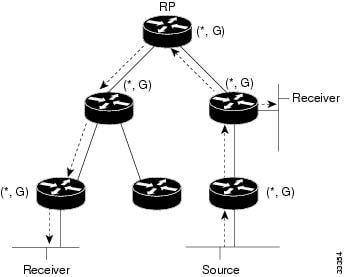
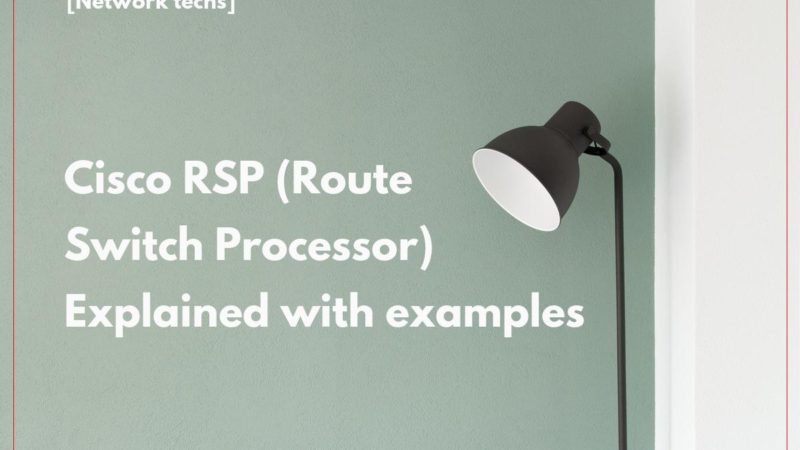
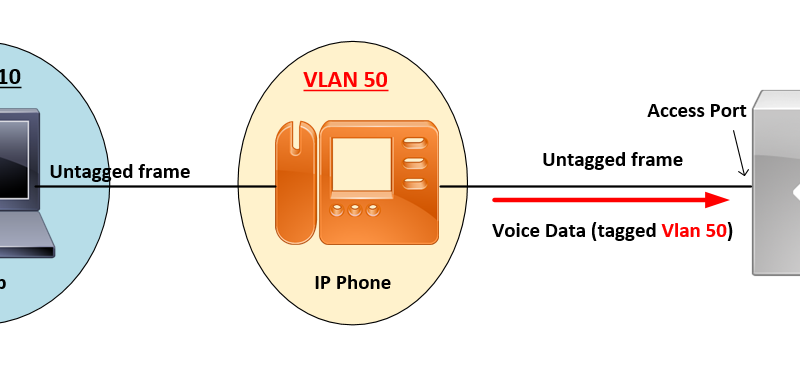
![OSPF DR and BDR Election Explained [with Configuration]](https://learnduty.com/wp-content/uploads/2022/03/image-33.png?v=1647900046)
![OSPF Neighbor Adjacency Requirements [With Configuration]](https://learnduty.com/wp-content/uploads/2022/03/image-23-418x450.png?v=1647900064)
![OSPF Neighbor States Explained [Step by Step]](https://learnduty.com/wp-content/uploads/2022/03/image-13.png?v=1647900076)
![OSPF Area Types Explained and Configuration [Demystified]](https://learnduty.com/wp-content/uploads/2022/03/image-8.png?v=1647900083)